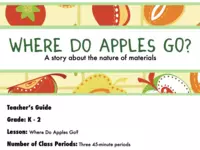https://static1.squarespace.com/static/5825f79f59cc6805946db437/t/589b3f23db29d6b63e08debf/1486569253698/Materials%2BCycle%2B-%2Bk-2_lessonplan.pdf
The Cloud Institute for Sustainability Education and Learner-Centered Initiatives
This learning activity takes two hours and 15 minutes.
Learn more about Teaching Climate Literacy and Energy Awareness»Grade Level
Online Readiness
Climate Literacy
This Activity builds on the following concepts of Climate Literacy.
Click a topic below for supporting information, teaching ideas, and sample activities.
Energy Literacy
This Activity builds on the following concepts of Energy Literacy.
Click a topic below for supporting information, teaching ideas, and sample activities.
Notes From Our Reviewers
The CLEAN collection is hand-picked and rigorously reviewed for scientific accuracy and classroom effectiveness.
Read what our review team had to say about this resource below or learn more about
how CLEAN reviews teaching materials
Teaching Tips | Science | Pedagogy |
Technical Details
Teaching Tips
- Consider extending the lesson by having students write/draw their answers to the questions.
- This lesson is an opportunity to discuss climate change and the effect of greenhouse gases being emitted by the production of human-made items.
- The lesson could likely be taught in one day rather than the three suggested.
About the Content
- In this lesson, students examine the differences between human-made and nature-made items. Students are encouraged to generate ideas on ways to reduce and/or reuse items.
- The main resource for this lesson is a picture book.
- The story does not address the problems that can come from littering even compostable materials like apples. For example, throwing food out the window on highways brings wildlife closer to roads, leading to more car-animal collisions. Educators should ensure that students realize that littering produce is not the appropriate way to dispose of it (composting is better).
- Passed initial science review - expert science review pending.
About the Pedagogy
- This lesson is taught over several days and begins with a story about the life of an apple/tree and guiding questions. The next day students work in small groups and compare explore an assortment of materials and categorize them by which are human-made vs made by nature.
- On the final day, students work in small groups again and select one of the human-made items and generate ideas on how to reduce/reuse them.
- If students need extra help, they could work with the teacher or an assistant as suggested in the resource. If writing is challenging for students, they could opt to draw a picture.
- This resource engages students in using scientific data.
See other data-rich activities
Technical Details/Ease of Use
- The supplemental material in this lesson is the storybook. The teacher might want to read the story beforehand to know where to pause/ask guiding questions. Access to the book is not provided in the lesson, but is available online.








